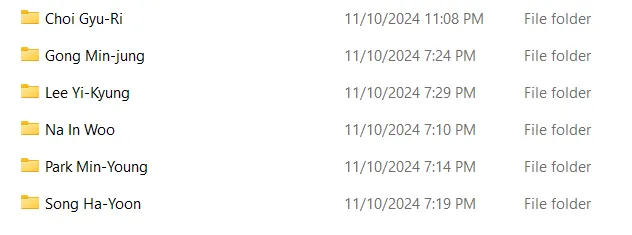影视场景中的演员识别
在观看电视剧时,我注意到会自动显示演员姓名。受此启发,我使用 AI 技术开发了自己的解决方案。

在观看电视剧时,我注意到一个有趣的功能,即在每个场景中显示演员姓名。我受到启发,使用 AI 技术开发了自己的解决方案,以实现相同的功能。

方法很简单:它使用人脸检测来提取演员的脸部,然后进行人脸识别来预测演员的名字。我使用 FaceNet 模型进行人脸检测和嵌入。
对于人脸识别部分,我通过了少样本学习来嵌入一些演员的脸部。有关更多信息,你可以阅读我之前的文章通过少样本学习释放图像分类的潜力。
在本文中,我选择了 Prime Video 平台上的韩剧《嫁给我的丈夫》来向你展示这个过程:

1、准备支持集
在此步骤中,我为剧中的所有演员准备了裁剪后的脸部图像,每个演员仅使用 5 张图片。



2、从 YouTube 下载视频
为了进行此演示,我使用Python 库 pytube 下载视频片段:
pip install pytubefix下载视频的代码:
import os
from pytubefix import YouTube
from pytubefix.cli import on_progress
def download_video(video_link: str, downloaded_video_path: str):
yt = YouTube(video_link, on_progress_callback=on_progress)
ys = yt.streams.get_highest_resolution()
if not os.path.exists(downloaded_video_path):
os.makedirs(downloaded_video_path)
ys.download(downloaded_video_path)3、将支持集中的人脸嵌入到向量中
我使用 FaceNet 模型,使用 keras-facenet 库从演员的面部中提取特征:
pip install keras-facenet模型初始化:
from keras_facenet import FaceNet
embedder = FaceNet()预处理图像和嵌入:
import os
import numpy as np
from typing import Tuple, List
# Source: https://dev.to/abhinowww/how-to-build-a-face-recognition-system-using-facenet-in-python-27kh
def preprocess(image: np.array) -> np.array:
image = cv2.resize(image, (160, 160))
image = np.expand_dims(image, axis=0)
return image
def get_support_set_vector(support_set_dir: str) -> Tuple[np.array, List[str]]:
actor_names = []
support_set_vectors = []
for actor_name in os.listdir(support_set_dir):
actor_names.append(actor_name)
actor_dir = os.path.join(support_set_dir, actor_name)
actor_features = []
for image_file in os.listdir(actor_dir):
image = cv2.imread(os.path.join(actor_dir, image_file))
image = cv2.cvtColor(image, cv2.COLOR_BGR2RGB)
image = preprocess(image)
feature = embedder.embeddings(image)
actor_features.append(feature[0])
support_set_vectors.append(np.mean(actor_features, axis=0))
return np.array(support_set_vectors), actor_names
support_set_vectors, actor_names = get_support_set_vector("./support_sets")
4、欧几里得距离
为了比较目标人脸与支持集中的人脸之间的相似度,我采用欧几里得距离:
def calculate_query_distance(
query_vector: np.array,
support_set_vectors: np.array
) -> float:
distances = np.linalg.norm(support_set_vectors - query_vector, axis=1)
return distances5、检测并识别演员
整合在一起,下面的代码检测视频中的人脸并识别是哪位演员:
video_path = os.path.join(
downloaded_video_path,
os.listdir(downloaded_video_path)[0]
)
video_capture = cv2.VideoCapture(video_path)
detection_threshold = 0.75
# Define font
font = cv2.FONT_HERSHEY_DUPLEX
font_scale = 0.5
font_color = (255, 255, 255)
font_thickness = 1
output_frames = []
success = True
while success:
success, image = video_capture.read()
if image is None:
continue
detections = embedder.extract(image, threshold=detection_threshold)
position = (10, 30)
y_offset = 0
for det in detections:
bbox = det["box"]
x1 = bbox[0]
y1 = bbox[1]
x2 = bbox[0] + bbox[2]
y2 = bbox[1] + bbox[3]
face = image[y1:y2, x1:x2, :]
face = preprocess(face)
face_feature = embedder.embeddings(face)
distances = calculate_query_distance(face_feature[0], support_set_vectors)
most_similar_indices = np.argsort(distances)
actor_name = actor_names[most_similar_indices[0]]
cv2.putText(
image,
actor_name,
(position[0], position[1] + y_offset),
font,
font_scale,
font_color,
font_thickness,
lineType=cv2.LINE_AA
)
y_offset += int(40 * font_scale)
output_frames.append(cv2.cvtColor(image, cv2.COLOR_BGR2RGB))6、视频叠加识别结果
为了将结果与原始视频相结合,我使用了 MoviePy 库:
pip install moviepy创建最终视频。注意:这代码是由 ChatGPT 生成的。
import moviepy.editor as mp
from moviepy.video.io.VideoFileClip import VideoFileClip
# Load the original video and extract audio
original_video = VideoFileClip(video_path)
audio = original_video.audio
fps = original_video.fps
# Create a video from annotated frames
annotated_clip = mp.ImageSequenceClip(output_frames, fps=fps)
annotated_clip = annotated_clip.set_audio(audio) # Add the original audio
# Export the final video
annotated_clip.write_videofile(
"/content/output_with_actor_name.mp4",
codec="libx264",
fps=fps,
audio_codec="aac"
)以下是最终输出的示例:

原文链接:How to Recognize Actor Names in Each Movie Scene Using AI
汇智网翻译整理,转载请表明出处